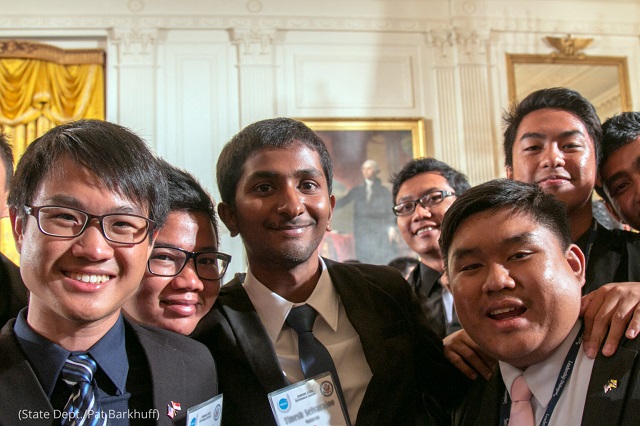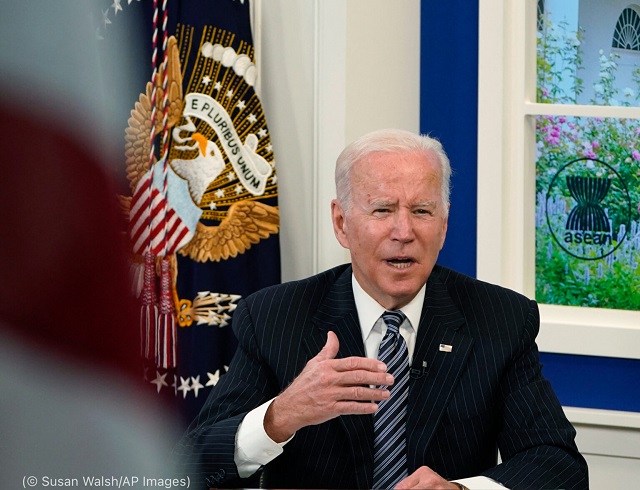For 45 years the United States and Southeast Asian nations have worked together to help their people live healthier, more prosperous lives.
America’s partnership with the Association of Southeast Asian Nations (ASEAN) began in 1977, a decade after the group was created to better address challenges in Southeast Asia. President Jimmy Carter attended the first U.S.-ASEAN Ministerial Meeting the next year.
Since then, the U.S. trade relationship with ASEAN nations has grown to support millions of jobs. During the past 20 years, the United States also has invested more than $3.63 billion in health assistance for ASEAN countries.
President Biden hosted the U.S.-ASEAN Special Summit May 12–13, 2022, in Washington to further advance long-standing U.S. ties with the more than 650 million people in ASEAN member countries.
“Our partnership is essential in maintaining a free and open Indo-Pacific, which has been the foundation of our shared security and prosperity for many decades,” Biden said at the U.S.-ASEAN Summit in October 2021.
At the October summit, Biden announced up to $102 million to support U.S.-ASEAN efforts to recover from COVID-19, strengthen health security, fight the climate crisis and spur economic growth, while promoting gender equality and deepening people-to-people ties.

Young Southeast Asian Leaders Initiative (YSEALI) fellows visit the White House in 2015. (State Dept./Pat Barkhuff)
ASEAN’s 10 member states are Brunei, Burma, Cambodia, Indonesia, Laos, Malaysia, the Philippines, Singapore, Thailand and Vietnam.
During the 1980s and 1990s the U.S. and ASEAN held 16 joint dialogues. Cooperation on economic development increased dramatically in 1999, with new programs to advance trade, investment, education and the transfer of technology.
In 2008, the U.S. became the first non-ASEAN country to name a representative to ASEAN. It established the U.S. Mission to ASEAN in Jakarta in 2010.
The U.S.-ASEAN Smart Cities Partnership, launched in 2018, brings U.S. public and private sector expertise to tackle urbanization challenges and improve quality of life in 26 cities in Southeast Asia. By February 2021, 20 projects were underway to improve transportation, water and resource reuse, and health systems.
The U.S.-ASEAN Smart Cities Partnership has invested in 20+ projects to support the 26 members of the ASEAN Smart Cities Network. These projects focus on water management, health, resource recovery and reuse, and sustainable transportation solutions. https://t.co/aBuR2vxkXD pic.twitter.com/q7WuE82mP0
— Department of State (@StateDept) December 22, 2020
Trade between the United States and ASEAN countries has also grown, with more than $360 billion in goods and services crossing the Pacific in 2020.
The United States and ASEAN also partner to:
- Combat illegal, unreported and unregulated fishing in the South China Sea and beyond. The people of ASEAN depend on the ocean for their food and livelihoods.
- Develop future leaders through programs such as the Young Southeast Asian Leaders Initiative, the Fulbright Program and technology fellowships. Prior to the COVID-19 pandemic, students in these programs were among nearly 60,000 people from ASEAN countries studying in the United States.
- Address the climate crisis and conserve critical ecosystems such as the Mekong River, through investment in renewable energy, building resilience, and satellite monitoring of forests and water supply.
- Respond to the COVID-19 pandemic and advance health security by providing COVID-19 vaccines, training health care workers and supporting testing labs.

President Biden participates virtually in the U.S.-ASEAN Summit from the White House on October 26, 2021. (© Susan Walsh/AP Images)
“It is a top priority for the Biden-Harris Administration to serve as a strong, reliable partner in Southeast Asia,” White House Press Secretary Jen Psaki said, announcing the special summit. “Our shared aspirations for the region will continue to underpin our common commitment to advance an Indo-Pacific that is free and open, secure, connected, and resilient.”
Banner image: A health care worker evaluates a patient before administering a dose of COVID-19 vaccine at a mass vaccination clinic in Indonesia in September 2021. (USAID/Indonesia)
The original article is here on ShareAmerica.







COMMENTS0
LEAVE A COMMENT
TOP